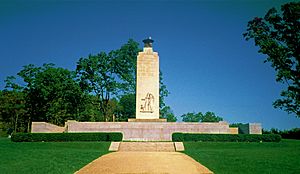Eternal Light Peace Memorial facts for kids

The memorial has "The Flame of Eternal Peace" and relief sculptures of two women and an American eagle.
|
|
| Coordinates | 39°50′54″N 77°14′36″W / 39.84845°N 77.24345°W |
|---|---|
| Location | Gettysburg National Military Park |
| Designer | Paul Philippe Cret Lee Lawrie |
| Type | Historic district contributing structure |
| Website | Park Scenes (nps.gov) |
The Eternal Light Peace Memorial is a special monument at the Gettysburg Battlefield. It was officially opened on July 3, 1938. This memorial remembers the 1913 Gettysburg reunion, which was a big meeting held 50 years after the Battle of Gettysburg in 1863.
The memorial features an eternal flame that burns using natural gas. This flame is inside a large bronze urn, which weighs one ton! The urn sits on top of a tower. This tower is part of a stone area where people can walk. From this spot, you can see about 400 square miles (1,036 km²) of the area. The flame itself can be seen from as far as 20 miles (32 km) away. It stands as a symbol of lasting peace.
Contents
Building the Peace Memorial
The idea for a peace memorial at Gettysburg began a long time ago. In 1887, some soldiers, including Colonel Andrew Cowan, suggested building a "grand monument to American Heroism." Later, in 1900, President William McKinley even talked about peace between the North and South with Colonel Cowan.
Early Plans and Challenges
In 1910, a plan for a monument was first suggested. It was presented to the U.S. Congress in 1912 for the 50th anniversary of the Battle of Gettysburg. However, Congress could not agree on funding the project at that time.
Instead of starting the monument, Colonel Andrew Cowan gave a speech in 1913. He spoke about the need for a peace memorial. After his speech, the Gettysburg Peace Memorial Association was formed. This group worked to get a bill passed in Congress in December 1913. This bill created the Gettysburg Memorial Commission.
Funding and Design
The first plan was for a $250,000 "monument of peace." It was supposed to be built at a place called The Angle. In 1914, people tried to get funding from the U.S. House of Representatives. They compared the planned memorial to famous structures like Christ the Redeemer of the Andes and the Lincoln Memorial. But federal funding was still delayed.
Years later, in August 1936, the memorial's commission sent out 10,000 flyers to share the plan. Virginia was the first state to provide money for the project in 1936. In 1937, Pennsylvania also started planning for a peace memorial. The state's "Peace Memorial Bill" was signed on February 24, 1937. It set aside $5,000 for the "Gettysburg Peace Memorial fund."
By August 1937, the committee chose from six different designs. On December 10, 1937, Lee Lawrie was chosen as the sculptor. The monument was planned to overlook Big Round Top and Little Round Top. With more money from New York, Indiana, Tennessee, Illinois, and Wisconsin, the $60,000 monument was finally built. It was placed northwest of Gettysburg, Pennsylvania. Work began on February 14, and the gas pipes for the flame were finished on May 31.
Dedication Ceremony
The memorial was dedicated on July 3, 1938, during the 1938 Gettysburg reunion. About 250,000 people attended the ceremony. Another 100,000 tried to come but could not because of crowded roads.
President Roosevelt's Visit
President Franklin D. Roosevelt arrived on a special train. The U.S. 3rd Cavalry Division escorted his car to the memorial. When he arrived, a 21-gun salute was fired.
Roosevelt used a new sound system to speak to the crowd. Veterans sat on special stands under a canopy. As his nine-minute speech ended at sunset, the Peace Memorial was unveiled. It had been covered by a 50-foot flag. Union veteran George N. Lockwood and Confederate veteran A. G. Harris, both 91 years old, unveiled it. A special sensor automatically lit the flame.
The ceremony ended with a prayer. On his way to his car, Roosevelt spoke with William Barnes, a 112-year-old veteran from the United States Colored Troops. As the President left, another 21-gun salute was fired.
Changes and Restoration
During World War II, the flame was reduced to a small pilot light. This happened from December 25, 1941. After the war, President Truman commented on the memorial's motto, Peace Eternal in a Nation United. He said, "That is what we want, but let's change that word (nation) to world and we'll have something."
The original stone used in the lower part of the memorial started to wear out. It was replaced with gray granite in June 1941. More repairs were made in 1950. In 1962, a protest against nuclear weapons was held at the memorial.
In 1974, the flame was put out because of the 1973 oil crisis. Congress even made a rule against such flames, except for the John F. Kennedy Eternal Flame. The gas flame was replaced by an electric light in 1976. However, in June 1988, a Gettysburg Peace Celebration committee was formed. They worked to restore the gas flame. It was relit on July 3, 1988, for the memorial's 50th anniversary.

